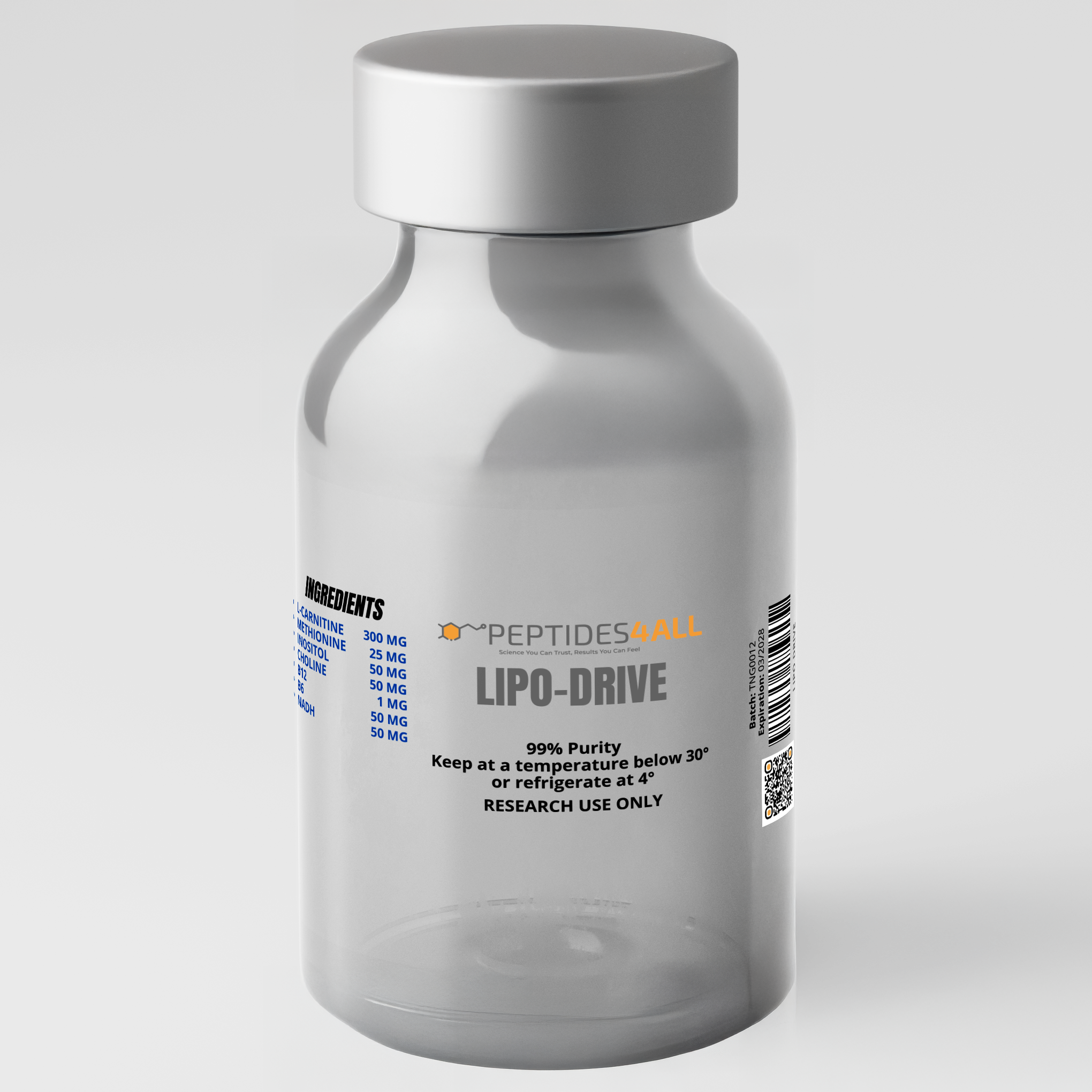PEPTIDES4ALL LIPO-DRIVE – Intramuscular Lipotropic & Energetic Metabolic Blend
LIPO-DRIVE IM is a sterile intramuscular (IM) injectable formulation designed for research use, combining a lipotropic and mitochondrial support matrix to promote fat mobilization, metabolic efficiency, hepatic function, and energy metabolism. This blend pairs classical lipid-metabolism cofactors with methyl donors and redox support agents for a multi-axis metabolic tool.
Composition (per dose):
-
L-Carnitine — 300 mg
-
Methionine — 25 mg
-
Inositol — 50 mg
-
Choline — 50 mg
-
Vitamin B12 — 1 mg
-
Vitamin B6 — 50 mg
-
NADH — 50 mg
Scientific Evidence & Research Findings
L-Carnitine (300 mg)
-
Carnitine is key to transporting long-chain fatty acids into mitochondria for β-oxidation, supporting energy production from fats. (Linus Pauling Institute)
-
Its roles are expanding beyond simple fatty acid transport — research now emphasizes its involvement in mitochondrial homeostasis, epigenetic regulation, inflammation, and inter-organ metabolic signaling. BioMed Central
-
Some meta-analyses show that supplemental L-carnitine (higher doses) can modestly improve lipid profiles (e.g. decreased LDL, improved HDL) in certain populations. PMC
Methionine & Methylation Cycle
-
Methionine is a principal methyl donor (via S-adenosylmethionine, SAM) in methylation reactions, gluathione synthesis, and detoxification pathways.
-
The methyl group donation from methionine and choline is critical in hepatic methyl-carbon metabolism. In bovine hepatocyte studies, choline and methionine differentially regulate methyl carbon pathways, with implications for VLDL export and oxidative stress mitigation. PLOS
-
Choline plays a critical role in hepatic lipid metabolism through its conversion to phosphatidylcholine via the phosphatidylethanolamine N-methyltransferase (PEMT) pathway. This process is essential for very-low-density lipoprotein (VLDL) synthesis and the export of triglycerides from the liver. The interplay between choline and methionine—both methyl donors in the S-adenosylmethionine (SAM) cycle—is fundamental to maintaining hepatic lipid balance and preventing steatosis.
(PMC Article: “Choline Metabolism Provides Novel Insights into Nonalcoholic Fatty Liver Disease
Inositol, Choline & B-Vitamins
-
Inositol plays roles in lipid signaling, insulin sensitivity, and cellular signaling pathways relevant to metabolic health (in the literature on PCOS, insulin resistance, etc.).
-
Choline is essential for liver function, lipid metabolism, and lipotropic action. Dietary choline is necessary for VLDL export and preventing hepatic fat accumulation. PMC
-
Vitamins B6 & B12 support energy metabolism, the methyl-folate cycle, mitochondrial function, and red blood cell formation — all of which are foundational in efficient metabolism and recovery.
NADH
-
NADH is a reduced coenzyme form of vitamin B3 (niacin) and plays a direct role in mitochondrial electron transport, ATP generation, redox balance, and cellular bioenergetics.
-
By supplying reducing equivalents, NADH may help support energetic demands in metabolic stress or exercise models, and facilitate oxidative metabolism.
Key Research Benefits & Applications
-
Fat Mobilization & Mitochondrial Oxidation: Carnitine transports fatty acids into mitochondria; NADH supplies reducing equivalents for electron transport; methionine/choline/inositol support hepatic lipid export and methyl cycle.
-
Hepatic Protection & Lipid Homeostasis: Methyl donors (methionine, choline) and inositol support liver methylation, VLDL export, and protect against hepatic steatosis.
-
Metabolic & Energetic Efficiency: B6/B12 ensure cofactor sufficiency; NADH helps energy chain flux; the blend aims to reduce metabolic bottlenecks.
-
Integrated Lipotropic Action: This formula offers multiple angles to support fat metabolism — substrate delivery, methyl support, redox balance, and mitochondrial drive.
Formulation, Handling & Storage
- Formulation: Sterile, preservative-free IM injectable solution
- Administration: Intramuscular injection (e.g. deltoid, gluteal) under sterile technique
- Storage: –20 °C, shielded from light and moisture; handle under lab protocols
Intended Use
For research purposes only. Must be handled in accordance with institutional protocols and ethical guidelines.
